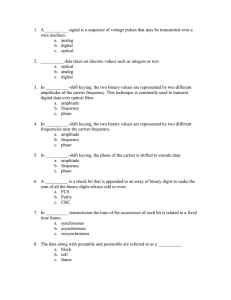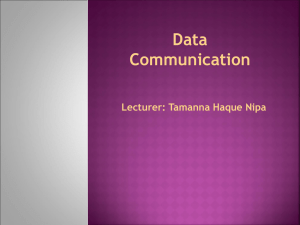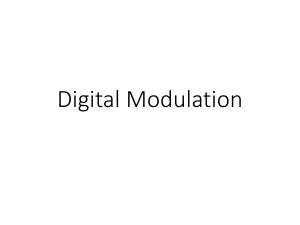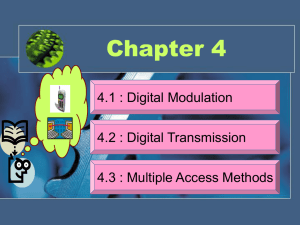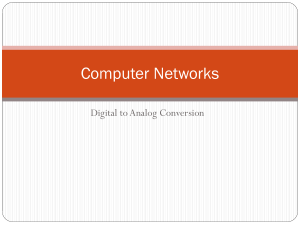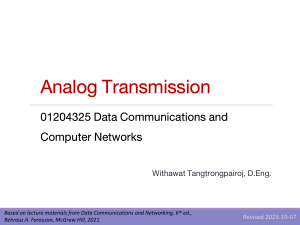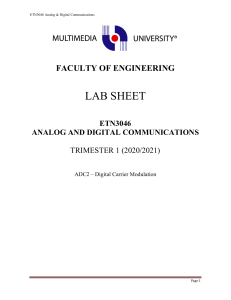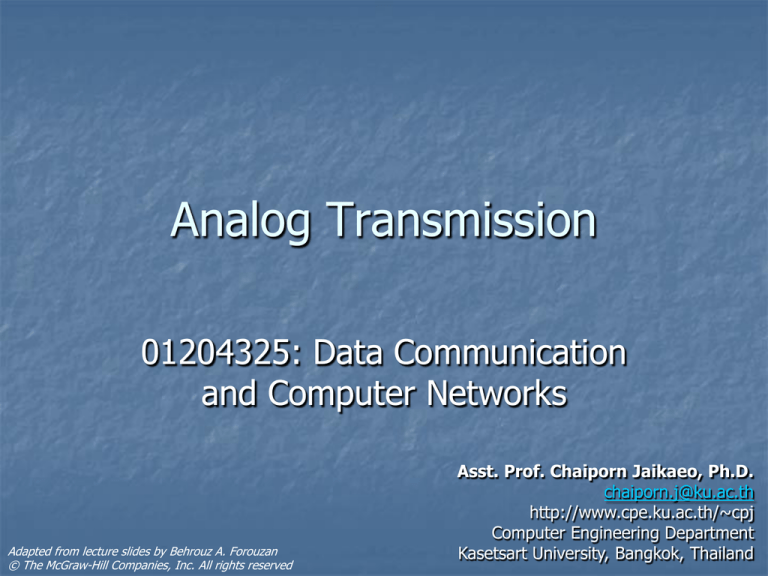
Analog Transmission
01204325: Data Communication
and Computer Networks
Adapted from lecture slides by Behrouz A. Forouzan
© The McGraw-Hill Companies, Inc. All rights reserved
Asst. Prof. Chaiporn Jaikaeo, Ph.D.
chaiporn.j@ku.ac.th
http://www.cpe.ku.ac.th/~cpj
Computer Engineering Department
Kasetsart University, Bangkok, Thailand
Outline
Aspects of Digital-to-Analog Conversion
Amplitude Shift Keying
Frequency Shift Keying
Phase Shift Keying
Quadrature Amplitude Modulation
2
Digital-to-Analog Conversion
Required to send digital data over a bandpass channel
Also known as modulation
(band-pass channel)
3
Carrier Signals
Carrier signal is a high-frequency signal
acting as a base for information signal
Also known as "Carrier Frequency"
4
Sine Waves Revisited
signal strength
period
T = 1/f
peak
amplitude
time
General form: x(t) = A×sin(2ft + )
phase / phase shift
5
Conversion Techniques
6
Bit Rate vs. Baud Rate
Bit rate the number of bits per second
Baud rate the number of signal elements per
second.
In the analog transmission of digital data, the
baud rate is less than or equal to the bit rate
7
Example 5.2
An analog signal has a bit rate of 8000 bps and a baud
rate of 1000 baud. How many data elements are
carried by each signal element? How many different
signal elements do we need?
Solution
In this example, S = 1000, N = 8000, and r and L are
unknown. We find first the value of r and then the value
of L.
8
Binary Amplitude Shift Keying
Or Binary ASK
Simplest form On-Off Keying (OOK)
fc – Carrier frequency
0 < d < 1
9
Implementation of Binary ASK
10
Example 5.3
We have an available bandwidth of 100 kHz which
spans from 200 to 300 kHz. What are the carrier
frequency and the bit rate if we modulated our data by
using ASK with d = 1?
Solution
The middle of the bandwidth is located at 250 kHz. This
means that our carrier frequency can be at fc = 250 kHz.
We can use the formula for bandwidth to find the bit rate
(with d = 1 and r = 1).
11
Full-Duplex ASK
Bandwidth can be divided into two to
support full-duplex communication
Two carrier frequencies are used
12
Binary Frequency Shift Keying
Or Binary FSK
13
Implementation of Binary FSK
14
Multilevel FSK
Use one frequency to send more than one
bit at a time
E.g., the whole bandwidth divided into 8
frequency ranges
15
Binary Phase Shift Keying
Or Binary PSK
16
Implementation of Binary PSK
17
Quadrature PSK
Each signal element carries 2 bits
18
Implementation of QPSK
19
Example 5.7
Find the bandwidth for a signal transmitting at 12
Mbps for QPSK. The value of d = 0.
Solution
For QPSK, 2 bits is carried by one signal element. This
means that r = 2. So the signal rate (baud rate) is S = N ×
(1/r) = 6 Mbaud. With a value of d = 0, we have B = S = 6
MHz.
20
Constellation Diagrams
A constellation diagram helps define the
amplitude and phase of a signal element
21
Example 5.8
Show the constellation diagrams for OOK,
BPSK, and QPSK modulations
22
Constellation Diagram for 8-PSK
23
Quadrature Amplitude Modulation
Or QAM
A combination of ASK and PSK
24
Telephone Line Bandwidth
25
V.32 and V.32bis Modem Standards
26
Analog-to-Analog Conversion
Process of transmitting analog information
by an analog signal
Although the signal is already analog,
modulation is needed if a band-pass
channel is available to us.
27
Types of Analog-to-Analog Modulations
28
Amplitude Modulation (AM)
29
AM Band Allocation
30
Frequency Modulation (FM)
31
FM Band Allocation
32
Phase Modulation (PM)
Considered a variation of FM
33

